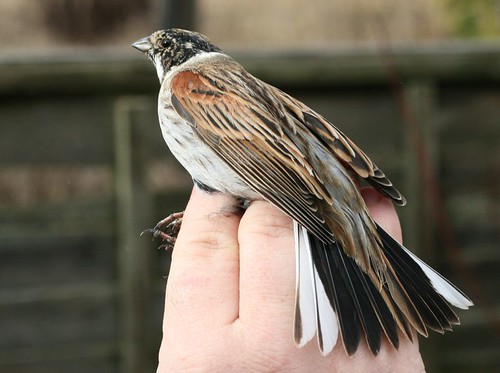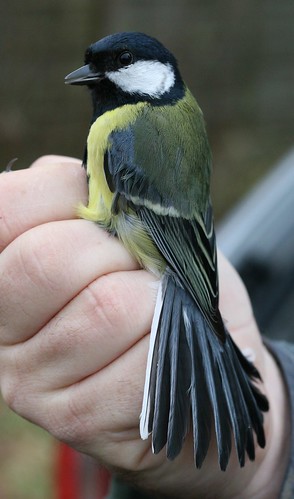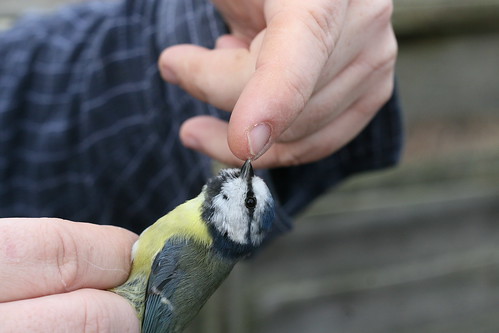We stood in the kitchen and watched birds flying over, under and round the side of the net. It was pretty dispiriting! Eventually we caught two Blue Tits and a Great Tit simultaneously, and then it got windy. So things weren't looking too good.
Fortunately, despite the wind and occasional drizzle, we did OK.
We caught two Reed Buntings (we've had as many as 15 in the garden at the same time this week), which was pretty good. This one's a male. The pale flecks on his head will soon wear away, revealing smart, plain black feathers underneath.
For a while it looked likely that the Reed Buntings would be the highlight of the morning. Then we caught this bird:
A Great Tit, you say. Not very interesting, surely. Well, the thing about this Great Tit is that it already had a ring, and it wasn't one that we'd put on. So it's come from somewhere else. In itself, that's interesting enough (we'll have to wait to find out where it was ringed).
The extra-interesting thing was that the ring was a size larger than normal - a B ring (AAs are the smallest, for things like Goldcrests and Willow Warblers, then As, and Bs are usually for birds like Greenfinches).
When young Great Tits are ringed in the nest as chicks (or pulli as ringers like to refer to them), they need the next ring size up. This is because their legs are actually fatter while they're developing!
The ring still fits OK now that the bird is a thinner-legged adult, but hopefully the person who ringed it will be really pleased to hear that one of their pulli has made it to adulthood. The reason that Great Tits have such huge families (up to 9 eggs) is because many of them - 62% on average - will die in their first year. So this guy has beaten the odds.
Now you want to know what happens when Blue Tits turn bad, right?
We take great care when handling birds, but it's a shame that Blue Tits do not reciprocate. Everybody thinks they're cute and fluffy, but this is the truth: they are fierce biters and nippers. It wouldn't let go and actually made Derek's finger bleed.
Anyway, here are today's totals:
- Blue Tit, 17 (+ 4 'retraps' we'd caught before)
- Great Tit, 11 (+ 4 retraps, including the special one)
- Greenfinch, 1
- Dunnock, 1
- Reed Bunting, 2
- Coal Tit, 2
photos taken with Canon EOS 30D



I have finally managed to get on a Ringing Introductory Course with BTO - originally I had to be on the waiting list. So come July I will discover whether I have an aptitude for this and then I can start to learn and help out with this very important research!
ReplyDeleteThe reason Blue tits have been doing well this winter - fighter's spirit!as demonstrated by you photo!
Interesting on the "special one"!
Katie,
ReplyDeleteDid not know you were a ringer, we call it bander here in the US. Meg's daughter spent 7 months banding birds in the jungle in Belize.
Ah yes, Blue Tits - i always wonder how something so small can inflict so much pain!
ReplyDeleteBe interesting to find out where your Great Tit came from - always good to find someone elses bird in your net eh?!
What's the greti ring number? Might just be one of ours!
ReplyDelete... or ours! (Ivel RG)
ReplyDeleteThanks for all your comments.
ReplyDeleteAfter some super detective work by Errol, we found out that the Great Tit was ringed in a nestbox in Stanwick, Northants, in May 2009! Which means it's flown a minimum of 36km (22 miles) to get here.
I'm really chuffed!